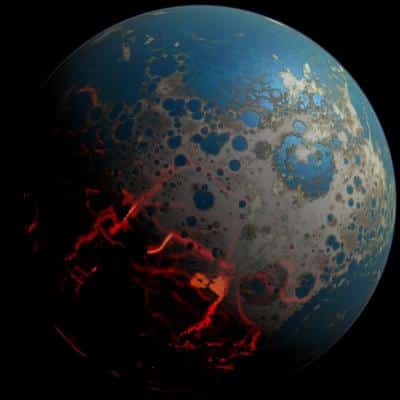Although in accretion rate terms, the last bombardment is responsible for less than XNUMX percent of today's Earth mass. Large asteroid collisions have had a major impact on Earth's geological evolution

New research shows that more than 4 billion years ago, the Earth's surface was reworked as a result of a giant asteroid impact. A new model based on data from the present Earth and Moon sheds light on the role of asteroid bombardment in the geological evolution of the upper layers of the early Earth, as well as how major impacts have affected Earth's history to the present day.
New research shows that over 4 billion years ago, the Earth's surface underwent reworking - mixing, burial and melting as a result of asteroid impacts. A new model of the Earth's bombardment based on contemporary data from the Earth and the Moon sheds light on the role that asteroid bombardments played in the evolution of the Earth's upper layers during the Tertiary period (about 4-4.5 billion years ago).
An international team of researchers published the findings in the July 31 issue of the journal Nature.
"When we look at the present, we have access to the geological past of the Earth for the last half billion years, and we understand that plate tectonics, volcanic activity and these other types of processes were more or less similar in their magnitudes for the last 2 billion years" says Lindy Elkins - Tanton, director of the School of Earth and Space Studies at the University of Arizona.
"However, we know less about the early days of the earth, the first half billion years, than about any other period, and we call this period the fruitful period (like hell), because we estimate that the earth was hot, volcanoes erupted everywhere and the trend It covered the entire surface, unlike nowadays."
Models of terrestrial planet formation show that the Earth went through a series of several 'growth' events: the accretion of planetesimals (tiny planets) and planetary embryos over tens of millions of years, a large impact that led to the formation of the Moon, and then the late bombardment when large asteroids struck cyclically on Earth, the last of which was the asteroid that wiped out the dinosaurs.
Although in accretion rate terms, the last bombardment is responsible for less than 4 percent of today's Earth mass. Large asteroid collisions had a major impact on the geological evolution of the early Earth. 4 billion years ago, the earth had a lava soil that melted the material that fell from the sky. Moreover, large collisions even 4.3 billion years ago caused the oceans to evaporate (evaporate?) into a steam atmosphere. Despite the heavy bombardment, the findings are consistent with the hypothesis that liquid water existed on Earth even XNUMX billion years ago based on geochemical data.
An important part of the mystery about the early days of the Earth that has not been sufficiently quantified in the past is the type of trauma that the Earth suffered at the end of the Age of Accretion. How big were the asteroids, how often did they arrive, and what was their effect on the Earth's surface? How did they affect the ability of today's cooled crust to create plates, break them up and cause plate tectonics? What types of volcanic eruptions did they create that were different from today's?
"We understand more and more the similarities and differences in the conditions that prevailed on Earth then and now and the process of creating the tectonic plates," says Elkins-Tanton, "and this research is an important step in that direction, trying to bridge that time from the impact of the huge accumulation that created the moon and the tectonic plates of Today they allowed us to live on the continents."
The new research reveals that severe asteroid collisions not only changed the geology of the young Earth but also played a major role in the next important development on Earth - life.
"In the period leading up to about four billion years ago, there was no large area on Earth's surface that survived unscathed by asteroid impacts or their aftermath," says Simon Marche, of NASA's Solar System Virtual Research Institute. "We have a new picture of the Hadean Earth, and this has an important implication on its ability to preserve life."
The major collisions had particularly severe effects on existing ecosystems.
Researchers have found that on average the Earth could have been hit by 1-6 asteroids with a diameter of over a thousand kilometers that could have caused the sterilization of life, and by 3-7 asteroids with a diameter of over 500 kilometers that could have caused the water in the oceans to evaporate.
"Subsequently, the gap between the major collisions was long enough to allow for intervals with more favorable conditions, at least on a local scale." Marche said. "All life that formed during the Hadean Age had to be resistant to high temperatures to survive such a violent time in Earth's history and thrive in the depths or niches on the ocean floor."

2 תגובות
Doo doo
How stupid you are. If Rambam were to read your nonsense, he would turn over in his grave. And if he met you, he would plant you in tar and feathers.
Everything is written in the Holy Torah book
And the land was chaos and darkness over an abyss!!!
The scientists copy the Torah and then attack the religious who are the leaders of science and progress